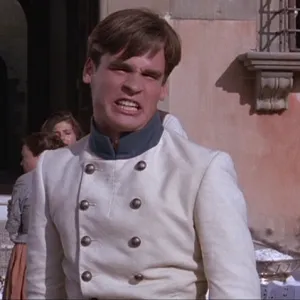
Anatomy of a Scene: Much Ado About Nothing, Hero’s Wedding
Much Ado About Nothing isn’t Shakespeare’s most famous play to tackle thorny issues of gender – The Taming of the Shrew has that honour – but it is certainly one of the most complicated: a play in which we can see a slyly radical idea butt up against social and theatrical convention.
Much Ado About Nothing follows the romantic arc of two couples: the lovelorn Hero and Claudio and the bickering Beatrice and Benedick. In the scene I have chosen as a window into the play, at what is supposed to be Claudio and Hero’s wedding, Claudio berates Hero in front of her father Leonato about her supposed tryst with another man. Unbeknownst to Claudio, that “tryst” was staged by the bitter, resentful Don John to ruin Claudio’s marriage; the woman Claudio believed to be Hero was in fact Margaret, one of her maids. The friar who has come to marry Hero and Claudio concocts a plan, with Hero and Leonato, to restore the marriage.
[A note for my lovely pedants: this not actually a full scene in the Shakespearean sense; the “scene” that I am referring to is the first two-thirds of Act IV, Scene I, encompassing lines 1-254. I hope you will allow that any single scene in Shakespeare, especially one that includes the infamous “were I a man” speech, offers too much meat to unpack in a blog post of reasonable length. Going forward I will be using the word scene to refer to the passage outlined above not the entirety of the scene]
This is an incredibly ugly scene in which a woman is framed, humiliated and berated by several different men, and all of it happens so that one man can avenge himself on another. The consequences for Hero, whose livelihood depends on her marriageability and whose marriageability depends on the popular perception of her chastity, are literally life-threatening.
What is so fascinating is that in the context of the scene, and by extension the play, it isn’t really the veracity of the claim against Hero that is at issue. The friar’s solution – for Hero to play dead and Leonato to blame Claudio for her death, thus guilting Claudio into realizing he was wrong to accuse her – has little to do with proving Hero’s innocence and more to do with showing men the deadly consequences for their actions. The lesson isn’t about importance of maidenly virtue but of gentlemanly behaviour. This radical idea eventually meets a conventional end, because of course Hero is pure and innocent, her reputation is restored, and after sufficient repentance Claudio’s ungentlemanly behaviour is rewarded with a wife.
Adaptations of Much Ado by Joss Whedon and Kenneth Branagh make for two interesting case studies because it’s clear from the get-go that neither would take the task lightly. Branagh, of course, has made his name in acting and directing Shakespeare, and although not classically trained, Whedon is certainly a Shakespeare aficionado, famous for gathering friends at his house for weekends of impromptu Shakespeare readings. Branagh’s period-set film of 1993 and Joss Whedon’s 2012 modernization offer two significantly different visions of Shakespeare’s play and tackle the thorny issues of misogyny and female agency in different ways.
**********
The most striking difference between the two adaptations is how they present these supposed gentleman, beginning with Claudio. Put simply, if Hero were your friend and she got back together with Whedon’s Claudio, you would be deeply ambivalent; if she got back together with Branagh’s Claudio, you would fear for her life.
 “Abuse” is the best word for what happens in Branagh’s version of the scene. Robert Sean Leonard’s Claudio is utterly furious and incredibly violent. He screams and sneers. He kicks and tears at the benches and garlanded tent poles erected for the wedding. He menaces guests in the crowd. At the line “There, Leonato, take her back again” he whips Hero by the arm toward him, not to bring her close but for better leverage to he can send her flying over a nearby bench and to the ground. It is an action designed for maximum force and pain. Every word he speaks to her drips with loathing and rage.
“Abuse” is the best word for what happens in Branagh’s version of the scene. Robert Sean Leonard’s Claudio is utterly furious and incredibly violent. He screams and sneers. He kicks and tears at the benches and garlanded tent poles erected for the wedding. He menaces guests in the crowd. At the line “There, Leonato, take her back again” he whips Hero by the arm toward him, not to bring her close but for better leverage to he can send her flying over a nearby bench and to the ground. It is an action designed for maximum force and pain. Every word he speaks to her drips with loathing and rage.

 By contrast the Claudio of Whedon’s film (played by Fran Kranz) is also angry, but his anger is mixed with heartache. He wears an expression of accusatory pain throughout much of the scene and delivers several of his lines tearfully, almost pleadingly.
By contrast the Claudio of Whedon’s film (played by Fran Kranz) is also angry, but his anger is mixed with heartache. He wears an expression of accusatory pain throughout much of the scene and delivers several of his lines tearfully, almost pleadingly.
 This version of Claudio isn’t stripped of the anger that makes him dangerous, but his violence is less explosive than Leonard’s. In this version Claudio paws at Hero, shakes her and at the same “take her back again line” shoves Hero away from him into Leonato’s arms, just not hard enough to knock her off her feet.
This version of Claudio isn’t stripped of the anger that makes him dangerous, but his violence is less explosive than Leonard’s. In this version Claudio paws at Hero, shakes her and at the same “take her back again line” shoves Hero away from him into Leonato’s arms, just not hard enough to knock her off her feet.
 An illustrative point of comparison is the moment in each version of the scene when Don John has to hold Claudio back: in Branagh’s version, it is to keep Claudio from striking Hero again; in Whedon’s, it is to keep him from comforting her after she has fainted. The difference in their performances boil down to the difference between the cheated and the cheated-on. Leonard’s Claudio was owed something and it has been stolen from him; Kranz’s Claudio has loved someone and she has betrayed him.
An illustrative point of comparison is the moment in each version of the scene when Don John has to hold Claudio back: in Branagh’s version, it is to keep Claudio from striking Hero again; in Whedon’s, it is to keep him from comforting her after she has fainted. The difference in their performances boil down to the difference between the cheated and the cheated-on. Leonard’s Claudio was owed something and it has been stolen from him; Kranz’s Claudio has loved someone and she has betrayed him.

 The Leonatos of each version act as mirror images of their Claudios: equally different in exactly the same way. The Leonato of Branagh’s adaptation, played by Richard Briers, is even more violent toward Hero than Claudio is. Once the three princes have left, he drags Hero, screaming, across the lawn by her hair.
The Leonatos of each version act as mirror images of their Claudios: equally different in exactly the same way. The Leonato of Branagh’s adaptation, played by Richard Briers, is even more violent toward Hero than Claudio is. Once the three princes have left, he drags Hero, screaming, across the lawn by her hair.
 Later he slaps her across the side of her face. His lines are delivered with spitting, red-faced rage which only breaks at the end of the scene. Like Claudio, Leonato is focused on his own rage and pain – for example, the line “Has any man here a dagger for me?” is spoken to himself in a moment of self-pity.
Later he slaps her across the side of her face. His lines are delivered with spitting, red-faced rage which only breaks at the end of the scene. Like Claudio, Leonato is focused on his own rage and pain – for example, the line “Has any man here a dagger for me?” is spoken to himself in a moment of self-pity.
 Until the wedding scene, Branagh’s film is all sunshiney, sepia-toned slapstick with beautiful bronzed bodies and mile-wide smiles, making the whiplash change of tone so unsettling. And in such an unsettling scene, it is the behaviour of Leonato – hitherto all twinkly eyes and paternal joviality – that is the most jarring of all. This scene exposes both he and Claudio for what they are: violent men whose love and good humour extends only so long as you never, ever cross them.
Like his Claudio, Whedon’s version of Leonato is still angry but certainly less violent. Clark Gregg delivers the dagger line in the classic parental tone of “I’m not angry, I’m disappointed.” Whedon stays true to the text and has this paternal disappointment be the cause of Hero’s fainting. Of course, this Leonato is actually angry, too. Whedon still includes the lines in which Leonato bemoans having but one child – this child – and Gregg also plays Leonato as physical with Hero, grasping her by the arms and bringing her face close to his. He doesn’t scream abuse at her or hit her, though, and like Claudio, his tone is one of imploring, as if he wants someone to contradict what he has heard.
If Branagh amplifies male violence and Whedon downplays it, the inverse is true for female agency. Branagh’s version of this scene undercuts its female characters at every turn. The most significant instance of this is Branagh’s cut of lines 177-83, Hero’s longest piece of speech in the scene. After Hero has fainted and been revived, she issues a challenge. She tells to Leonato to “prove you that any man with me conversed/at hours unmeet” if, and only if, he can prove these accusations can he “refuse me, hate me, torture me to death.” It’s a small but incredibly important moment for a character given very little to say and who exists to be married, preferably but not necessarily to the man of her choosing. It is the most agency Hero demonstrates on-stage in the entire play.
Branagh cuts this speech entirely; in his version of this scene Hero gets two lines in total and lots of inarticulate screaming. Whedon, on the other hands, includes this speech in its entirety and his direction emphasizes its importance. While uttering this challenge, his Hero (Jillian Morgese) literally rises up, standing from the ground and getting in her father’s face. Morgese’s delivery is teary and heartbroken, not aggressive, but her words are a challenge just the same and takes up equal space in the frame.
Until the wedding scene, Branagh’s film is all sunshiney, sepia-toned slapstick with beautiful bronzed bodies and mile-wide smiles, making the whiplash change of tone so unsettling. And in such an unsettling scene, it is the behaviour of Leonato – hitherto all twinkly eyes and paternal joviality – that is the most jarring of all. This scene exposes both he and Claudio for what they are: violent men whose love and good humour extends only so long as you never, ever cross them.
Like his Claudio, Whedon’s version of Leonato is still angry but certainly less violent. Clark Gregg delivers the dagger line in the classic parental tone of “I’m not angry, I’m disappointed.” Whedon stays true to the text and has this paternal disappointment be the cause of Hero’s fainting. Of course, this Leonato is actually angry, too. Whedon still includes the lines in which Leonato bemoans having but one child – this child – and Gregg also plays Leonato as physical with Hero, grasping her by the arms and bringing her face close to his. He doesn’t scream abuse at her or hit her, though, and like Claudio, his tone is one of imploring, as if he wants someone to contradict what he has heard.
If Branagh amplifies male violence and Whedon downplays it, the inverse is true for female agency. Branagh’s version of this scene undercuts its female characters at every turn. The most significant instance of this is Branagh’s cut of lines 177-83, Hero’s longest piece of speech in the scene. After Hero has fainted and been revived, she issues a challenge. She tells to Leonato to “prove you that any man with me conversed/at hours unmeet” if, and only if, he can prove these accusations can he “refuse me, hate me, torture me to death.” It’s a small but incredibly important moment for a character given very little to say and who exists to be married, preferably but not necessarily to the man of her choosing. It is the most agency Hero demonstrates on-stage in the entire play.
Branagh cuts this speech entirely; in his version of this scene Hero gets two lines in total and lots of inarticulate screaming. Whedon, on the other hands, includes this speech in its entirety and his direction emphasizes its importance. While uttering this challenge, his Hero (Jillian Morgese) literally rises up, standing from the ground and getting in her father’s face. Morgese’s delivery is teary and heartbroken, not aggressive, but her words are a challenge just the same and takes up equal space in the frame.
 By the time Hero concludes, Leonato has embraced her head and the two collapse to the ground, intertwined in a weepy embrace. In Whedon’s version, it this small moment of agency on Hero’s part (not the persuasions of the friar that immediately follow) which tempers Leonato’s anger and reunites Hero with her father.
It is not just Hero whose lines are cut in Branagh’s adaptation; he also cuts lines from Beatrice as well. In the text, after the princes have left, Benedick asks Beatrice how Hero is and she replies, “Dead, I think. Help, uncle … Uncle, Signor Benedick, Friar.” Beatrice is deliberately emotionally manipulating Leonato and Benedick and calling them and the friar out for their inaction. Branagh cuts these lines completely (again, Whedon leaves them in). In fact, it’s worth noting that in this scene inarticulate screams make up a significant portion of female vocalization.
By the time Hero concludes, Leonato has embraced her head and the two collapse to the ground, intertwined in a weepy embrace. In Whedon’s version, it this small moment of agency on Hero’s part (not the persuasions of the friar that immediately follow) which tempers Leonato’s anger and reunites Hero with her father.
It is not just Hero whose lines are cut in Branagh’s adaptation; he also cuts lines from Beatrice as well. In the text, after the princes have left, Benedick asks Beatrice how Hero is and she replies, “Dead, I think. Help, uncle … Uncle, Signor Benedick, Friar.” Beatrice is deliberately emotionally manipulating Leonato and Benedick and calling them and the friar out for their inaction. Branagh cuts these lines completely (again, Whedon leaves them in). In fact, it’s worth noting that in this scene inarticulate screams make up a significant portion of female vocalization.
 Branagh’s direction also suggests female fragility. Hero is brought to the ground well before Shakespeare has her faint. She is literally abject, spending most of her time on the ground as men loom over her. By contrast Whedon’s Hero is standing until she faints under her father’s criticism, and even then, she rises almost immediately. This Hero also stands up for herself when Claudio is berating her; at one point, he literally holds out his arms as if to fend her off. Her expression and body language suggest a desire to comfort not harm, but putting Claudio on the defensive enhances a sense of Hero’s power.
Branagh’s direction also suggests female fragility. Hero is brought to the ground well before Shakespeare has her faint. She is literally abject, spending most of her time on the ground as men loom over her. By contrast Whedon’s Hero is standing until she faints under her father’s criticism, and even then, she rises almost immediately. This Hero also stands up for herself when Claudio is berating her; at one point, he literally holds out his arms as if to fend her off. Her expression and body language suggest a desire to comfort not harm, but putting Claudio on the defensive enhances a sense of Hero’s power.
 A similar comparison can be made between the two versions of Beatrice. In Branagh’s version of this scene, Beatrice fends off an attack from Claudio by throwing an elbow; in Whedon’s, Leonato has to hold Beatrice back from rushing at Claudio.
A similar comparison can be made between the two versions of Beatrice. In Branagh’s version of this scene, Beatrice fends off an attack from Claudio by throwing an elbow; in Whedon’s, Leonato has to hold Beatrice back from rushing at Claudio.
 The female character with the most confusing treatment at Branagh’s hand is Margaret, Hero’s maid and unwitting decoy in the plot against her. The play’s stage directions do not suggest that Margaret is present for this scene, but in Branagh’s adaptation she is part of Hero’s wedding party. When Don Pedro describes “witnessing” Hero caught in the act, a look of dawning horror crosses Margaret’s face.
The female character with the most confusing treatment at Branagh’s hand is Margaret, Hero’s maid and unwitting decoy in the plot against her. The play’s stage directions do not suggest that Margaret is present for this scene, but in Branagh’s adaptation she is part of Hero’s wedding party. When Don Pedro describes “witnessing” Hero caught in the act, a look of dawning horror crosses Margaret’s face.
 This moment suggests that Margaret realizes the mistake that has been made – and does nothing. It is an interesting choice – it gives her a degree of complicity in what happens to Hero – but it becomes frustrating when you realize that, unlike the other characters of the play, she will never be able to explain her actions. That Margaret fears for her position and livelihood if she were discovered sleeping with men in her mistress’ room (and clothes) is one possible assumption, but the viewer cannot actually know her motives because she does not speak.
This decision is part of a fairly significant reshaping of Margaret’s character and her relationship with Hero. Preceding the aborted wedding scene in the text is a sweet moment in which Margaret and Hero gently, wittily tease Beatrice about her affections for Benedick. This moment implies an intimacy and friendliness between the three women (and has the refreshing effect of showing a woman other than Beatrice – and a serving woman, no less – who has a way with words). Branagh cuts this scene entirely.
**********
It’s worth stepping back for a moment and considering what each director is doing with their adaptation of Much Ado About Nothing, and why, through the lens of gender, neither of these well-crafted films feel entirely satisfying.
Whedon’s apparent vision for his adaptation and his stance toward the play’s gender problems is easy enough to grasp: he is making this story and Shakespeare’s language accessible and engaging to the average 21st century film goer. His directorial choices all appear consistent with this, and he accomplishes it beautifully. He establishes and sustains a consistent tone for his film. There are dramatic moments and there are moments of witty or slapstick humor, but a melancholy bittersweetness pervades the entire film, as if he has taken both the light and the dark of Shakespeare’s story and blended them evenly throughout.
Amplifying the agency of the female characters and minimizing the misogyny of the male ones is a critical part of Whedon’s update. Setting Much Ado About Nothing in the present without those changes while maintaining its original ending and its comedy would be unpalatable to a modern audience, especially the young female audience that makes up much of Whedon’s viewing audience.
Whedon’s film is certainly a more comfortable viewing experience, but the longer you think about that comfort the more uncomfortable it becomes. Whedon’s modernizations allow the viewer to readily and sometimes unthinkingly laugh at or root for characters we might otherwise find abhorrent (including Claudio, who is still physically violent toward Hero, and Leonato, who still believes a male acquaintance over his own daughter and tells her she’d be better off dead). In redirecting the violence and anger into expressions of pain and heartbreak, Whedon’s film runs the risk of camouflaging misogyny as love.
By contrast, in Branagh’s film everything is played to the hilt, resulting in a tonal roller coaster that veers wildly from giddy camp to the explosive violence detailed above, all wrapped up with the classic comedy ending. Branagh amplifyies everything, male violence included, and the result is a sort of Shakespeare to the max. In staging the play so violently, he thrusts the misogyny of this “comedy” in the viewer’s face and makes it impossible for them to look away.
However, Branagh’s film is by his own unnecessary undermining of Much Ado‘s female characters. The unspeaking complicity of Margaret, for one, muddles what he himself presents as a vengeful, male-driven act. But more importantly, in stripping the female characters, specifically Hero, of their agency, Branagh flattens them into one-dimensional victims. In Branagh’s hands, Hero becomes a spectacle of abjection rather than a person struggling to wrest some small degree of agency in a system designed to keep her powerless. Of course, women do not have to be completely meek and helpless to suffer the effects of misogyny and male violence. To suggest otherwise is a vast oversimplification of how patriarchy works and who – and how – it hurts.
Ultimately, it might be impossible to film (or stage) a “perfect” Much Ado About Nothing, especially when it comes to teasing apart the dense, complicated exploration of gender issues. The play itself is leaves the viewer unsatisfied and uneasy: Shakespeare offers a strong critique of male violence and the perilous positions it forces women to occupy, but is ultimately bound by social and genre convention and lets his male characters off the hook with the bare minimum of repentance. Fitting, then, that neither adaptation of Much Ado About Nothing offers any concrete answers or easy solutions but – like all literature and film worth a damn – both offer endless fodder for thought and discussion.
Note: The actor playing Claudio in Kenneth Branagh’s adaptation was incorrectly identified as Sean Patrick Leonard; his actual name is Robert Sean Leonard. The post has been updated accordingly, but thank you to the eagle-eyed commenters who pointed it out!
This moment suggests that Margaret realizes the mistake that has been made – and does nothing. It is an interesting choice – it gives her a degree of complicity in what happens to Hero – but it becomes frustrating when you realize that, unlike the other characters of the play, she will never be able to explain her actions. That Margaret fears for her position and livelihood if she were discovered sleeping with men in her mistress’ room (and clothes) is one possible assumption, but the viewer cannot actually know her motives because she does not speak.
This decision is part of a fairly significant reshaping of Margaret’s character and her relationship with Hero. Preceding the aborted wedding scene in the text is a sweet moment in which Margaret and Hero gently, wittily tease Beatrice about her affections for Benedick. This moment implies an intimacy and friendliness between the three women (and has the refreshing effect of showing a woman other than Beatrice – and a serving woman, no less – who has a way with words). Branagh cuts this scene entirely.
**********
It’s worth stepping back for a moment and considering what each director is doing with their adaptation of Much Ado About Nothing, and why, through the lens of gender, neither of these well-crafted films feel entirely satisfying.
Whedon’s apparent vision for his adaptation and his stance toward the play’s gender problems is easy enough to grasp: he is making this story and Shakespeare’s language accessible and engaging to the average 21st century film goer. His directorial choices all appear consistent with this, and he accomplishes it beautifully. He establishes and sustains a consistent tone for his film. There are dramatic moments and there are moments of witty or slapstick humor, but a melancholy bittersweetness pervades the entire film, as if he has taken both the light and the dark of Shakespeare’s story and blended them evenly throughout.
Amplifying the agency of the female characters and minimizing the misogyny of the male ones is a critical part of Whedon’s update. Setting Much Ado About Nothing in the present without those changes while maintaining its original ending and its comedy would be unpalatable to a modern audience, especially the young female audience that makes up much of Whedon’s viewing audience.
Whedon’s film is certainly a more comfortable viewing experience, but the longer you think about that comfort the more uncomfortable it becomes. Whedon’s modernizations allow the viewer to readily and sometimes unthinkingly laugh at or root for characters we might otherwise find abhorrent (including Claudio, who is still physically violent toward Hero, and Leonato, who still believes a male acquaintance over his own daughter and tells her she’d be better off dead). In redirecting the violence and anger into expressions of pain and heartbreak, Whedon’s film runs the risk of camouflaging misogyny as love.
By contrast, in Branagh’s film everything is played to the hilt, resulting in a tonal roller coaster that veers wildly from giddy camp to the explosive violence detailed above, all wrapped up with the classic comedy ending. Branagh amplifyies everything, male violence included, and the result is a sort of Shakespeare to the max. In staging the play so violently, he thrusts the misogyny of this “comedy” in the viewer’s face and makes it impossible for them to look away.
However, Branagh’s film is by his own unnecessary undermining of Much Ado‘s female characters. The unspeaking complicity of Margaret, for one, muddles what he himself presents as a vengeful, male-driven act. But more importantly, in stripping the female characters, specifically Hero, of their agency, Branagh flattens them into one-dimensional victims. In Branagh’s hands, Hero becomes a spectacle of abjection rather than a person struggling to wrest some small degree of agency in a system designed to keep her powerless. Of course, women do not have to be completely meek and helpless to suffer the effects of misogyny and male violence. To suggest otherwise is a vast oversimplification of how patriarchy works and who – and how – it hurts.
Ultimately, it might be impossible to film (or stage) a “perfect” Much Ado About Nothing, especially when it comes to teasing apart the dense, complicated exploration of gender issues. The play itself is leaves the viewer unsatisfied and uneasy: Shakespeare offers a strong critique of male violence and the perilous positions it forces women to occupy, but is ultimately bound by social and genre convention and lets his male characters off the hook with the bare minimum of repentance. Fitting, then, that neither adaptation of Much Ado About Nothing offers any concrete answers or easy solutions but – like all literature and film worth a damn – both offer endless fodder for thought and discussion.
Note: The actor playing Claudio in Kenneth Branagh’s adaptation was incorrectly identified as Sean Patrick Leonard; his actual name is Robert Sean Leonard. The post has been updated accordingly, but thank you to the eagle-eyed commenters who pointed it out!
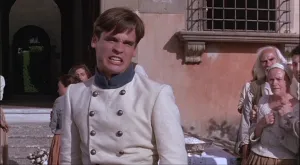 “Abuse” is the best word for what happens in Branagh’s version of the scene. Robert Sean Leonard’s Claudio is utterly furious and incredibly violent. He screams and sneers. He kicks and tears at the benches and garlanded tent poles erected for the wedding. He menaces guests in the crowd. At the line “There, Leonato, take her back again” he whips Hero by the arm toward him, not to bring her close but for better leverage to he can send her flying over a nearby bench and to the ground. It is an action designed for maximum force and pain. Every word he speaks to her drips with loathing and rage.
“Abuse” is the best word for what happens in Branagh’s version of the scene. Robert Sean Leonard’s Claudio is utterly furious and incredibly violent. He screams and sneers. He kicks and tears at the benches and garlanded tent poles erected for the wedding. He menaces guests in the crowd. At the line “There, Leonato, take her back again” he whips Hero by the arm toward him, not to bring her close but for better leverage to he can send her flying over a nearby bench and to the ground. It is an action designed for maximum force and pain. Every word he speaks to her drips with loathing and rage.

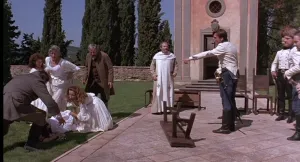 By contrast the Claudio of Whedon’s film (played by Fran Kranz) is also angry, but his anger is mixed with heartache. He wears an expression of accusatory pain throughout much of the scene and delivers several of his lines tearfully, almost pleadingly.
By contrast the Claudio of Whedon’s film (played by Fran Kranz) is also angry, but his anger is mixed with heartache. He wears an expression of accusatory pain throughout much of the scene and delivers several of his lines tearfully, almost pleadingly.
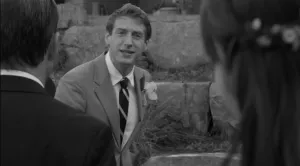 This version of Claudio isn’t stripped of the anger that makes him dangerous, but his violence is less explosive than Leonard’s. In this version Claudio paws at Hero, shakes her and at the same “take her back again line” shoves Hero away from him into Leonato’s arms, just not hard enough to knock her off her feet.
This version of Claudio isn’t stripped of the anger that makes him dangerous, but his violence is less explosive than Leonard’s. In this version Claudio paws at Hero, shakes her and at the same “take her back again line” shoves Hero away from him into Leonato’s arms, just not hard enough to knock her off her feet.
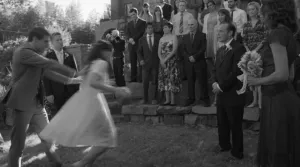 An illustrative point of comparison is the moment in each version of the scene when Don John has to hold Claudio back: in Branagh’s version, it is to keep Claudio from striking Hero again; in Whedon’s, it is to keep him from comforting her after she has fainted. The difference in their performances boil down to the difference between the cheated and the cheated-on. Leonard’s Claudio was owed something and it has been stolen from him; Kranz’s Claudio has loved someone and she has betrayed him.
An illustrative point of comparison is the moment in each version of the scene when Don John has to hold Claudio back: in Branagh’s version, it is to keep Claudio from striking Hero again; in Whedon’s, it is to keep him from comforting her after she has fainted. The difference in their performances boil down to the difference between the cheated and the cheated-on. Leonard’s Claudio was owed something and it has been stolen from him; Kranz’s Claudio has loved someone and she has betrayed him.
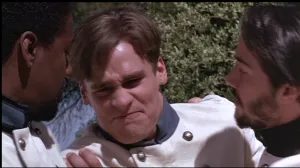
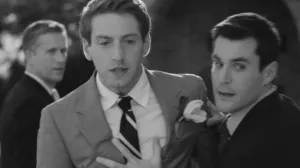 The Leonatos of each version act as mirror images of their Claudios: equally different in exactly the same way. The Leonato of Branagh’s adaptation, played by Richard Briers, is even more violent toward Hero than Claudio is. Once the three princes have left, he drags Hero, screaming, across the lawn by her hair.
The Leonatos of each version act as mirror images of their Claudios: equally different in exactly the same way. The Leonato of Branagh’s adaptation, played by Richard Briers, is even more violent toward Hero than Claudio is. Once the three princes have left, he drags Hero, screaming, across the lawn by her hair.
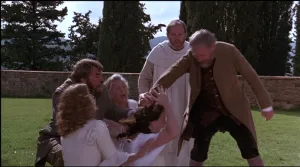 Later he slaps her across the side of her face. His lines are delivered with spitting, red-faced rage which only breaks at the end of the scene. Like Claudio, Leonato is focused on his own rage and pain – for example, the line “Has any man here a dagger for me?” is spoken to himself in a moment of self-pity.
Later he slaps her across the side of her face. His lines are delivered with spitting, red-faced rage which only breaks at the end of the scene. Like Claudio, Leonato is focused on his own rage and pain – for example, the line “Has any man here a dagger for me?” is spoken to himself in a moment of self-pity.
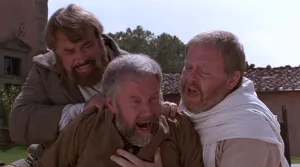 Until the wedding scene, Branagh’s film is all sunshiney, sepia-toned slapstick with beautiful bronzed bodies and mile-wide smiles, making the whiplash change of tone so unsettling. And in such an unsettling scene, it is the behaviour of Leonato – hitherto all twinkly eyes and paternal joviality – that is the most jarring of all. This scene exposes both he and Claudio for what they are: violent men whose love and good humour extends only so long as you never, ever cross them.
Like his Claudio, Whedon’s version of Leonato is still angry but certainly less violent. Clark Gregg delivers the dagger line in the classic parental tone of “I’m not angry, I’m disappointed.” Whedon stays true to the text and has this paternal disappointment be the cause of Hero’s fainting. Of course, this Leonato is actually angry, too. Whedon still includes the lines in which Leonato bemoans having but one child – this child – and Gregg also plays Leonato as physical with Hero, grasping her by the arms and bringing her face close to his. He doesn’t scream abuse at her or hit her, though, and like Claudio, his tone is one of imploring, as if he wants someone to contradict what he has heard.
If Branagh amplifies male violence and Whedon downplays it, the inverse is true for female agency. Branagh’s version of this scene undercuts its female characters at every turn. The most significant instance of this is Branagh’s cut of lines 177-83, Hero’s longest piece of speech in the scene. After Hero has fainted and been revived, she issues a challenge. She tells to Leonato to “prove you that any man with me conversed/at hours unmeet” if, and only if, he can prove these accusations can he “refuse me, hate me, torture me to death.” It’s a small but incredibly important moment for a character given very little to say and who exists to be married, preferably but not necessarily to the man of her choosing. It is the most agency Hero demonstrates on-stage in the entire play.
Branagh cuts this speech entirely; in his version of this scene Hero gets two lines in total and lots of inarticulate screaming. Whedon, on the other hands, includes this speech in its entirety and his direction emphasizes its importance. While uttering this challenge, his Hero (Jillian Morgese) literally rises up, standing from the ground and getting in her father’s face. Morgese’s delivery is teary and heartbroken, not aggressive, but her words are a challenge just the same and takes up equal space in the frame.
Until the wedding scene, Branagh’s film is all sunshiney, sepia-toned slapstick with beautiful bronzed bodies and mile-wide smiles, making the whiplash change of tone so unsettling. And in such an unsettling scene, it is the behaviour of Leonato – hitherto all twinkly eyes and paternal joviality – that is the most jarring of all. This scene exposes both he and Claudio for what they are: violent men whose love and good humour extends only so long as you never, ever cross them.
Like his Claudio, Whedon’s version of Leonato is still angry but certainly less violent. Clark Gregg delivers the dagger line in the classic parental tone of “I’m not angry, I’m disappointed.” Whedon stays true to the text and has this paternal disappointment be the cause of Hero’s fainting. Of course, this Leonato is actually angry, too. Whedon still includes the lines in which Leonato bemoans having but one child – this child – and Gregg also plays Leonato as physical with Hero, grasping her by the arms and bringing her face close to his. He doesn’t scream abuse at her or hit her, though, and like Claudio, his tone is one of imploring, as if he wants someone to contradict what he has heard.
If Branagh amplifies male violence and Whedon downplays it, the inverse is true for female agency. Branagh’s version of this scene undercuts its female characters at every turn. The most significant instance of this is Branagh’s cut of lines 177-83, Hero’s longest piece of speech in the scene. After Hero has fainted and been revived, she issues a challenge. She tells to Leonato to “prove you that any man with me conversed/at hours unmeet” if, and only if, he can prove these accusations can he “refuse me, hate me, torture me to death.” It’s a small but incredibly important moment for a character given very little to say and who exists to be married, preferably but not necessarily to the man of her choosing. It is the most agency Hero demonstrates on-stage in the entire play.
Branagh cuts this speech entirely; in his version of this scene Hero gets two lines in total and lots of inarticulate screaming. Whedon, on the other hands, includes this speech in its entirety and his direction emphasizes its importance. While uttering this challenge, his Hero (Jillian Morgese) literally rises up, standing from the ground and getting in her father’s face. Morgese’s delivery is teary and heartbroken, not aggressive, but her words are a challenge just the same and takes up equal space in the frame.
 By the time Hero concludes, Leonato has embraced her head and the two collapse to the ground, intertwined in a weepy embrace. In Whedon’s version, it this small moment of agency on Hero’s part (not the persuasions of the friar that immediately follow) which tempers Leonato’s anger and reunites Hero with her father.
It is not just Hero whose lines are cut in Branagh’s adaptation; he also cuts lines from Beatrice as well. In the text, after the princes have left, Benedick asks Beatrice how Hero is and she replies, “Dead, I think. Help, uncle … Uncle, Signor Benedick, Friar.” Beatrice is deliberately emotionally manipulating Leonato and Benedick and calling them and the friar out for their inaction. Branagh cuts these lines completely (again, Whedon leaves them in). In fact, it’s worth noting that in this scene inarticulate screams make up a significant portion of female vocalization.
By the time Hero concludes, Leonato has embraced her head and the two collapse to the ground, intertwined in a weepy embrace. In Whedon’s version, it this small moment of agency on Hero’s part (not the persuasions of the friar that immediately follow) which tempers Leonato’s anger and reunites Hero with her father.
It is not just Hero whose lines are cut in Branagh’s adaptation; he also cuts lines from Beatrice as well. In the text, after the princes have left, Benedick asks Beatrice how Hero is and she replies, “Dead, I think. Help, uncle … Uncle, Signor Benedick, Friar.” Beatrice is deliberately emotionally manipulating Leonato and Benedick and calling them and the friar out for their inaction. Branagh cuts these lines completely (again, Whedon leaves them in). In fact, it’s worth noting that in this scene inarticulate screams make up a significant portion of female vocalization.
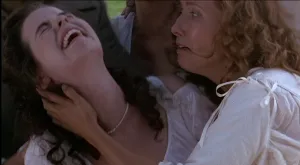 Branagh’s direction also suggests female fragility. Hero is brought to the ground well before Shakespeare has her faint. She is literally abject, spending most of her time on the ground as men loom over her. By contrast Whedon’s Hero is standing until she faints under her father’s criticism, and even then, she rises almost immediately. This Hero also stands up for herself when Claudio is berating her; at one point, he literally holds out his arms as if to fend her off. Her expression and body language suggest a desire to comfort not harm, but putting Claudio on the defensive enhances a sense of Hero’s power.
Branagh’s direction also suggests female fragility. Hero is brought to the ground well before Shakespeare has her faint. She is literally abject, spending most of her time on the ground as men loom over her. By contrast Whedon’s Hero is standing until she faints under her father’s criticism, and even then, she rises almost immediately. This Hero also stands up for herself when Claudio is berating her; at one point, he literally holds out his arms as if to fend her off. Her expression and body language suggest a desire to comfort not harm, but putting Claudio on the defensive enhances a sense of Hero’s power.
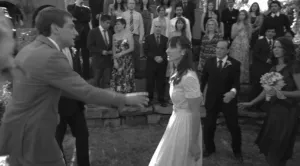 A similar comparison can be made between the two versions of Beatrice. In Branagh’s version of this scene, Beatrice fends off an attack from Claudio by throwing an elbow; in Whedon’s, Leonato has to hold Beatrice back from rushing at Claudio.
A similar comparison can be made between the two versions of Beatrice. In Branagh’s version of this scene, Beatrice fends off an attack from Claudio by throwing an elbow; in Whedon’s, Leonato has to hold Beatrice back from rushing at Claudio.
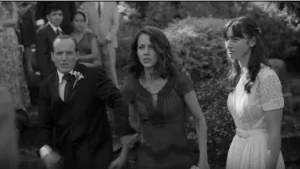 The female character with the most confusing treatment at Branagh’s hand is Margaret, Hero’s maid and unwitting decoy in the plot against her. The play’s stage directions do not suggest that Margaret is present for this scene, but in Branagh’s adaptation she is part of Hero’s wedding party. When Don Pedro describes “witnessing” Hero caught in the act, a look of dawning horror crosses Margaret’s face.
The female character with the most confusing treatment at Branagh’s hand is Margaret, Hero’s maid and unwitting decoy in the plot against her. The play’s stage directions do not suggest that Margaret is present for this scene, but in Branagh’s adaptation she is part of Hero’s wedding party. When Don Pedro describes “witnessing” Hero caught in the act, a look of dawning horror crosses Margaret’s face.
 This moment suggests that Margaret realizes the mistake that has been made – and does nothing. It is an interesting choice – it gives her a degree of complicity in what happens to Hero – but it becomes frustrating when you realize that, unlike the other characters of the play, she will never be able to explain her actions. That Margaret fears for her position and livelihood if she were discovered sleeping with men in her mistress’ room (and clothes) is one possible assumption, but the viewer cannot actually know her motives because she does not speak.
This decision is part of a fairly significant reshaping of Margaret’s character and her relationship with Hero. Preceding the aborted wedding scene in the text is a sweet moment in which Margaret and Hero gently, wittily tease Beatrice about her affections for Benedick. This moment implies an intimacy and friendliness between the three women (and has the refreshing effect of showing a woman other than Beatrice – and a serving woman, no less – who has a way with words). Branagh cuts this scene entirely.
**********
It’s worth stepping back for a moment and considering what each director is doing with their adaptation of Much Ado About Nothing, and why, through the lens of gender, neither of these well-crafted films feel entirely satisfying.
Whedon’s apparent vision for his adaptation and his stance toward the play’s gender problems is easy enough to grasp: he is making this story and Shakespeare’s language accessible and engaging to the average 21st century film goer. His directorial choices all appear consistent with this, and he accomplishes it beautifully. He establishes and sustains a consistent tone for his film. There are dramatic moments and there are moments of witty or slapstick humor, but a melancholy bittersweetness pervades the entire film, as if he has taken both the light and the dark of Shakespeare’s story and blended them evenly throughout.
Amplifying the agency of the female characters and minimizing the misogyny of the male ones is a critical part of Whedon’s update. Setting Much Ado About Nothing in the present without those changes while maintaining its original ending and its comedy would be unpalatable to a modern audience, especially the young female audience that makes up much of Whedon’s viewing audience.
Whedon’s film is certainly a more comfortable viewing experience, but the longer you think about that comfort the more uncomfortable it becomes. Whedon’s modernizations allow the viewer to readily and sometimes unthinkingly laugh at or root for characters we might otherwise find abhorrent (including Claudio, who is still physically violent toward Hero, and Leonato, who still believes a male acquaintance over his own daughter and tells her she’d be better off dead). In redirecting the violence and anger into expressions of pain and heartbreak, Whedon’s film runs the risk of camouflaging misogyny as love.
By contrast, in Branagh’s film everything is played to the hilt, resulting in a tonal roller coaster that veers wildly from giddy camp to the explosive violence detailed above, all wrapped up with the classic comedy ending. Branagh amplifyies everything, male violence included, and the result is a sort of Shakespeare to the max. In staging the play so violently, he thrusts the misogyny of this “comedy” in the viewer’s face and makes it impossible for them to look away.
However, Branagh’s film is by his own unnecessary undermining of Much Ado‘s female characters. The unspeaking complicity of Margaret, for one, muddles what he himself presents as a vengeful, male-driven act. But more importantly, in stripping the female characters, specifically Hero, of their agency, Branagh flattens them into one-dimensional victims. In Branagh’s hands, Hero becomes a spectacle of abjection rather than a person struggling to wrest some small degree of agency in a system designed to keep her powerless. Of course, women do not have to be completely meek and helpless to suffer the effects of misogyny and male violence. To suggest otherwise is a vast oversimplification of how patriarchy works and who – and how – it hurts.
Ultimately, it might be impossible to film (or stage) a “perfect” Much Ado About Nothing, especially when it comes to teasing apart the dense, complicated exploration of gender issues. The play itself is leaves the viewer unsatisfied and uneasy: Shakespeare offers a strong critique of male violence and the perilous positions it forces women to occupy, but is ultimately bound by social and genre convention and lets his male characters off the hook with the bare minimum of repentance. Fitting, then, that neither adaptation of Much Ado About Nothing offers any concrete answers or easy solutions but – like all literature and film worth a damn – both offer endless fodder for thought and discussion.
Note: The actor playing Claudio in Kenneth Branagh’s adaptation was incorrectly identified as Sean Patrick Leonard; his actual name is Robert Sean Leonard. The post has been updated accordingly, but thank you to the eagle-eyed commenters who pointed it out!
This moment suggests that Margaret realizes the mistake that has been made – and does nothing. It is an interesting choice – it gives her a degree of complicity in what happens to Hero – but it becomes frustrating when you realize that, unlike the other characters of the play, she will never be able to explain her actions. That Margaret fears for her position and livelihood if she were discovered sleeping with men in her mistress’ room (and clothes) is one possible assumption, but the viewer cannot actually know her motives because she does not speak.
This decision is part of a fairly significant reshaping of Margaret’s character and her relationship with Hero. Preceding the aborted wedding scene in the text is a sweet moment in which Margaret and Hero gently, wittily tease Beatrice about her affections for Benedick. This moment implies an intimacy and friendliness between the three women (and has the refreshing effect of showing a woman other than Beatrice – and a serving woman, no less – who has a way with words). Branagh cuts this scene entirely.
**********
It’s worth stepping back for a moment and considering what each director is doing with their adaptation of Much Ado About Nothing, and why, through the lens of gender, neither of these well-crafted films feel entirely satisfying.
Whedon’s apparent vision for his adaptation and his stance toward the play’s gender problems is easy enough to grasp: he is making this story and Shakespeare’s language accessible and engaging to the average 21st century film goer. His directorial choices all appear consistent with this, and he accomplishes it beautifully. He establishes and sustains a consistent tone for his film. There are dramatic moments and there are moments of witty or slapstick humor, but a melancholy bittersweetness pervades the entire film, as if he has taken both the light and the dark of Shakespeare’s story and blended them evenly throughout.
Amplifying the agency of the female characters and minimizing the misogyny of the male ones is a critical part of Whedon’s update. Setting Much Ado About Nothing in the present without those changes while maintaining its original ending and its comedy would be unpalatable to a modern audience, especially the young female audience that makes up much of Whedon’s viewing audience.
Whedon’s film is certainly a more comfortable viewing experience, but the longer you think about that comfort the more uncomfortable it becomes. Whedon’s modernizations allow the viewer to readily and sometimes unthinkingly laugh at or root for characters we might otherwise find abhorrent (including Claudio, who is still physically violent toward Hero, and Leonato, who still believes a male acquaintance over his own daughter and tells her she’d be better off dead). In redirecting the violence and anger into expressions of pain and heartbreak, Whedon’s film runs the risk of camouflaging misogyny as love.
By contrast, in Branagh’s film everything is played to the hilt, resulting in a tonal roller coaster that veers wildly from giddy camp to the explosive violence detailed above, all wrapped up with the classic comedy ending. Branagh amplifyies everything, male violence included, and the result is a sort of Shakespeare to the max. In staging the play so violently, he thrusts the misogyny of this “comedy” in the viewer’s face and makes it impossible for them to look away.
However, Branagh’s film is by his own unnecessary undermining of Much Ado‘s female characters. The unspeaking complicity of Margaret, for one, muddles what he himself presents as a vengeful, male-driven act. But more importantly, in stripping the female characters, specifically Hero, of their agency, Branagh flattens them into one-dimensional victims. In Branagh’s hands, Hero becomes a spectacle of abjection rather than a person struggling to wrest some small degree of agency in a system designed to keep her powerless. Of course, women do not have to be completely meek and helpless to suffer the effects of misogyny and male violence. To suggest otherwise is a vast oversimplification of how patriarchy works and who – and how – it hurts.
Ultimately, it might be impossible to film (or stage) a “perfect” Much Ado About Nothing, especially when it comes to teasing apart the dense, complicated exploration of gender issues. The play itself is leaves the viewer unsatisfied and uneasy: Shakespeare offers a strong critique of male violence and the perilous positions it forces women to occupy, but is ultimately bound by social and genre convention and lets his male characters off the hook with the bare minimum of repentance. Fitting, then, that neither adaptation of Much Ado About Nothing offers any concrete answers or easy solutions but – like all literature and film worth a damn – both offer endless fodder for thought and discussion.
Note: The actor playing Claudio in Kenneth Branagh’s adaptation was incorrectly identified as Sean Patrick Leonard; his actual name is Robert Sean Leonard. The post has been updated accordingly, but thank you to the eagle-eyed commenters who pointed it out!












